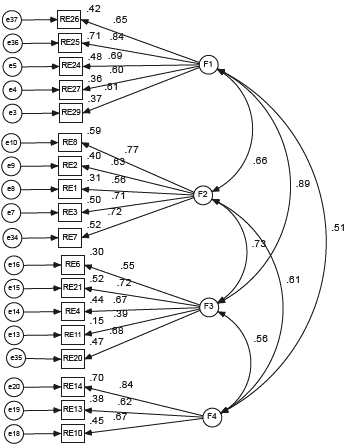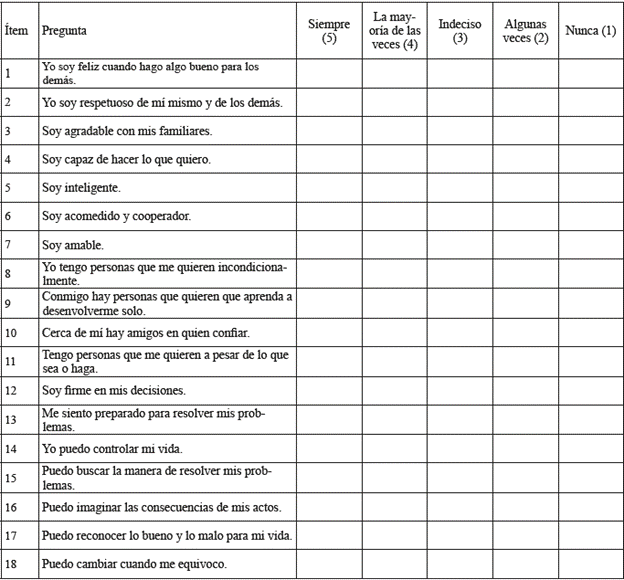Introduction
The study of human resilience goes back to the seventies and has its origins in clinical psychology, specifically in the research on positive adjustment to risk conditions for child development (Masten, 2018), finding a fertile niche in positive psychology, which focuses on potentialities over deficits and pathology (Belykh, 2018).
Despite the interest in this construct, there is no consensus on its definition, the factors that compose it and how to measure it (Luthar, 2015; Luthar & Cushing, 2002). With regard to the concept, it is possible to identify three aspects of convergence among the main definitions. In the first place, the notion of adversity, referring to the presence of one or more accumulated risk factors, or to the existence of an unexpected calamity. Second, the reference to a positive adaptation to this adversity, which not only implies facing it, but be strengthened by it. Finally, there is the conception of resilience as a process, rather than as an inherent characteristic of the person (Masten, 2018; Rutter, 2012).
Regarding the last point, there was a change from a first generation of studies that considered resilience as a distinctive feature of the person, to understanding it as a process (García-Vesga & Domínguez de la Ossa, 2013), in which individual, family and social factors interact (Luthar, 2015).
At the individual level, the main characteristics associated with resilience are: a high IQ, task-oriented coping styles and problem solving, self-management, locus of internal control, social skills and empathy, planning, sense of humor, self-esteem, commitment, capacity for reflection or introspection (Luthar, 2015; Rutter, 2012; Walsh, 2004). In the same way, at the individual level, biological issues such as the physiological responses involved in resilient adaptations have been considered (Monroy & Palacios, 2011). In the family environment, shared belief systems, organizational processes, communication and problem solving are variables that stand out (Walsh, 2004). From the social sphere, social networks and social cohesion are aspects considered to support resilience (Luthar, 2015).
The assessment of resilience and its dimensions is essential for the study of the phenomenon. Luthar and Cushing (2002) point out that in the measurement of this construct, usually at least one of the aforementioned elements is highlighted, that is, the instruments are directed to the study of resilience as the overcoming of adversity, as a form of adaptation, or, as a process. In the assessments of adversity, the risk of multiple specific life factors is estimated. The measurement of positive adaptation considers the level of adjustment in different stages of development, or the absence of pathology. The assessment of resilience as a process is done either through statistical analysis on the relationship of risk variables and positive adaptation, or by distinguishing between resilient subjects and those who are not (Luthar & Cushing, 2002).
Windle, Bennet and Noyes (2011) analyzed the 15 most reported resilience measurement instruments in the literature. Of the total of instruments analyzed, seven of them are directed to young or adolescent population and one to child population. Table 1 briefly describes these instruments and the factors these evaluate:
In the specialized literature available in Spanish, there are researches that hold that a greater degree of resilience leads to the overcoming of adverse life events (Barcelata, Durán & Gómez-Maqueo, 2012); it acts as a protective variable against suicide (Quiceno, Mateus, Cárdenas, Villareal & Vinaccia, 2013; Sánchez-Teruel & Robles-Bello, 2014; Villalobos-Galvis, Arévalo & Rojas, 2012); has a significant positive association with self-esteem (González-Arratia, Reyes, Valdéz & González, 2011); it can be favored in the school environment through meaningful activities involving adolescents (Arón & Milicic, 2011); promotes resilient resources from the family and the school; protects teenagers from unwanted pregnancy and drug use (Aguiar & Acle-Tomasini, 2012); and is related to lower levels of depression (Restrepo-Restrepo, Vinaccia & Quiceno, 2011). Similarly, it is argued that programs aimed at developing resilience buffer the effects of poverty and stress (Fiorentino, 2008).
In Mexico, there are three resilience instruments aimed at children and young people: Mexican Resilience Scale (Escala Mexicana de Resiliencia, RESI-M, Palomar & Gómez, 2010), the adaptation of the Resilience Scale for Adolescents (Escala de Resiliencia paraAdolescentes, READ, Ruvalcaba-Romero, Gallegos-Guajardo & Villegas-Guinea, 2014), and the Resilience Questionnaire for Children and Adolescents (Cuestionario de resiliencia para niños y adolescentes,González-Arratia, 2016).
Table 1 Description of instruments that assess resilience in young people and children.
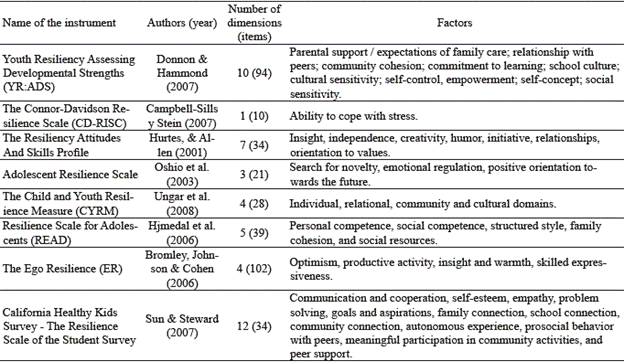
Note. Prepared from Windle et al. (2011).
The "Escala de Resiliencia Mexicana" (RESI-M) is the Mexican adaptation of two instruments originally published in English: The Connor-Davidson Resilience Scale (CD-RISC, Connor & Davidson, 2003) and The Resilience Scale for Adults (RSA, Friborg, Hjemdal, Rosenvinge & Martinussen, 2001). It is aimed at people between 18 and 25 years old, having a high level of reliability (α = .93). By means of the analysis of principal components with varimax rotation, a factorial structure of five dimensions was obtained, which explains 43.6% of the variance: strength and self-confidence, with19 items (α = .92); social competence, with 8 items (α = .87); family support, with 6 items (α = .87); social support with 5 items (α = .84); and structure, with 5 items (α = .79) (Palomar & Gómez, 2010).
The instrument has been used in adolescents to analyze the relationship between resilience and happiness versus urban marginalization in Mexico, finding a negative relationship between marginalization and resilience, as well as a positive relationship between resilience and happiness (Gómez-Azcárate, Vera, Ávila, Musitu, Vega & Dorantes, 2014).
The "Escala de Resiliencia para Adolescentes", was developed from the adaptation of the "The Resilience Scale for Adolescents" (READ, Hjemdal, Friborg, Stiles, Martinussen & Rosenvinge, 2006). The adaptation to Mexican population was carried out in adolescents between 12 and 17 years old, using the Principal Components method, finding a five dimensions structure with 22 items. Four of the original factors were preserved: family cohesion (α = .82), social competence (α = .73), personal competence (α = .64) and social resources (α = .70), while the fifth dimension, structured style, was eliminated. In the validation process, the authors added a factor called goal orientation (α = .60, Ruvalcaba-Romero et al., 2014).
For the adapted version, significant correlations are reported with socio-emotional competencies and self-esteem, as well as significant negative correlations with anxiety and depression (Ruvalcaba-Romero et al., 2014). The READ for Mexican population was used in a study on parental practices, finding that greater autonomy, communication and parental behavioral control promote a higher level of resilience in the adolescents (Ruvalcaba-Romero, Gallegos-Guajardo, Caballo & Villegas-Guinea, 2016).
The "Cuestionario de resilienciapara niños y adolescentes" is an instrument developed and studied with Mexican population. Through a factorial analysis of principal components with varimax rotation, three dimensions were obtained, explaining 37.82% of the variance: internal protective factors (α = .80), that assess interpersonal and problem-solving abilities; external protective factors (α = .73), indicating the family support perceived by the adolescent; finally, empathy (α =.78) which values the altruistic and prosocial behavior. The total Cronbach's alpha reported is 0.91 (González-Arratia, 2011).
The questionnaire is based on the theoretical model of Grotberg (2006), and has been used to study the relationship between resilience and various variables such as: self-esteem, resistant personality, parental bond, coping styles, locus of control and spirituality (González- Arratia, 2016). It has been evaluated as part of the psychological capital in relation to the healthy lifestyle (González-Cantero, Oropeza, Padrós, Colunga, Montes & González, 2017). Likewise, the relationship between resilience and optimism was analyzed, presenting a reliability level for the total scale of α = 0.88, and the dimensions of internal protective factors (α =80), external protective factors (α =0.73), and empathy (α =0.78) (González & Valdez, 2012). Although several studies have been done with this instrument, until now, the dimensionality of the scale has not been reported through confirmatory factor analysis, and no studies comparing the fit of different models have been found.
Among the main limitations in resilience measurement, the ones to be highlighted are the lack of standards, the need for the scales to have more robust validation methods and the possible cultural and contextual differences that might exist in the meaning of the construct (Windle et al., 2011). In the same way, the lack of valid and reliable instruments limits the possibility to develop comparisons with scientific rigor (Luthar & Cushing, 2002). Thus, the aim of this study was to analyze the psychometric properties of the Resilience Questionnaire for Children and Adolescents in a sample of high school students.
Method
Type of study
Descriptive cross-sectional, which consists of the measurement of variables in a single moment, at a given time (Álvarez, González & Chávez, 2017).
Participants
A total of 512 students from an urban public high school in Guadalajara, Mexico participated, of which 55.7% (285) were women and 44.3% (227) were men. The mean age was 15 years (SD = 0.54), with a range of 14 to 18 years. The participants were chosen in a non-probabilistic manner, through a propositive sampling.
Instruments
Cuestionario de resiliencia para niños y adolescentes [Questionnaire for Children and Adolescents] (González-Arratia, 2016). It consists of 32 items whose response options are Likert type ranging from 1 = never to 5 = always. It consists of three dimensions: external protective factors, internal protective factors and empathy. The rest of the characteristics and properties of the instrument were previously described in the introduction section.
Rosenberg Self-esteem Scale. The instrument was validated in a population of100 Mexican adolescents between 13 and 15 years of age, where the 66.2% of the variance was explained (González-Forteza & Rodríguez, 1993). It consists of 10 items that evaluate thoughts and feelings of personal worth and self-respect. The answer format goes from 1 = totally agree to 4 = totally disagree. Items 1, 2, 4, 6 and 7 are recoded to obtain a theoretical range of10 to 40, higher scores represent a higher level of self-esteem. A level of acceptable internal consistency with a Cronbach's alpha of 0.68 to 0.78 (adapted from Jiménez, Mondragón, & González-Forteza, 2007) has been reported in a Mexican adolescent population, agreeing with the results found in the present investigation.
Escala de Depresión del Centro de Estudios Epidemiológicos - Revisada (CES-D-R, for its Spanish acronym). [ Depression Scale from the Center of Epidemiological Studies-Revised] (González-Forteza, Jiménez-Tapia, Ramos-Lira & Wagner, 2008). It is composed of 35 items that evaluate the presence of depressive symptoms in the last two weeks, whose response options in a Likert scale are: 0 = 0 days, 1 = 1-2 days, 2 = 3-4 days, 3 = 5-7 days, 4 = 8-14 days. In a sample of 1549 students with a mean age of 14 years (SD = 1.2), a factorial analysis was performed with extraction of main components and oblique rotation, identifying six factors that explain 54.61% of the variance: depressed affect (α = .90) with five items, positive affect (α = .80) with three items, emotional insecurity and interpersonal problems (α = .94) with ten items, somatization (α = .91) with seven items, emotional well-being (α = .81) with three items and, delayed activity (α = .92) with six items. In the present investigation, the reliability levels, in the order of appearance of the factors described above were: 0.86, 0.83, 0.88, 0.83, 0.79 and 0.76, all of them within acceptable levels.
Process
The instruments were administered online through intact groups constituted by class groups. The tests were applied through Google forms in the school's computer labs during regular school hours. Once the instruction to answer the instruments was carried out, doubts were clarified, the average response time was 20 minutes. The first-year students that had an informed consent letter from their parents or guardians and, that agreed to participate voluntarily in the study, were considered, being informed about the confidentiality of the data. The study was endorsed by an ethics committee and the school authorities, adhering to national and international ethical guidelines.
Data analysis
In order to avoid the capitalization of chance, data were randomly divided in two samples of approximately 50%, where one of them was used for the exploratory factor analysis (n = 251), using the SPSS program in its version 23, and the other, for confirmatory factor analysis (n = 261) through the AMOS version 16 program.
For the items analysis, means, standard deviations, asymmetry and kurtosis were calculated, as well as the statistic of the Kolmogorov-Smirnov test and the level of significance, to evaluate the normality of the distribution.
An Exploratory Factorial Analysis was carried out using the principal component method with orthogonal varimax rotation, based on eigenvalues greater than 1. The Kaiser-Meyer-Olkin (KMO) test values greater than .80 and the significance of the sphericity Bartlett test were taken into consideration.
The indicators used for the confirmatory factor analysis were, in the first place, the absolute adjustment indexes: Goodness of fit Index (GFI), and the Goodness of fit Index corrected (AGFC), with values between .90 and .95 reflecting a good model fit. The root mean square error of approximation (RMSEA), with values between .05 and .08, considered as a reasonable adjustment (Schumacker & Lomax, 2010), and the root mean square residual (RMR), considering values less than .05 (Escobedo, Hernández, Estebané & Martínez, 2016).
The incremental adjustment indicators considered were: the normed fit index (NFI), the Tucker and Lewis adjustment index (TLI), whose values between .90 and .95 indicate a good fit (Schumacker & Lomax, 2010). The comparative fit index (CFI) greater than .95 and the incremental fit index (IFI) close to .95 were also considered, as well as the Akaike (AIC) and Bayesian (BIC) information criteria to compare models with different factors, where lower values indicate a better fit (Kline, 2011).
The calculation of the reliability coefficient of the scales and their dimensions was carried out using the Cronbach alpha indicator. For the evaluation of convergent and divergent validity, the Spearman correlation test was performed between the dimensions of resilience and the scales of self-esteem and depression, constructs with which resilience has been related (González-Arratia et al., 2011; Restrepo-Restrepo et al., 2011).
Results
In this section, the factorization of the questionnaire is shown first, followed by the adjustment of the model obtained. Subsequently, reliability measures by dimension are exposed to finish with indicators of convergent and divergent validity.
Exploratory Factor Analysis
The sample for the Exploratory Factor Analysis (AFE) included 251 participants, with 57.8% (145) of women and 42.2% (106) of men. The mean age was 14.99 years (SD = .529), with a minimum of 14 and a maximum of 18.
In order to evaluate the normality of the distribution, the Kolmogorov-Smirnov test was applied, from which it turned out (See Table 2) that the items did not comply with this assumption. However, asymmetry parameters ± 2 and kurtosis ± 7 are taken as criteria in which a behavior similar to normal can be considered (Abad, Olea, Ponsoda & García, 2011, Curran, West & Finch, 1996). The items that exceeded these values were discarded, because they caused specification errors in the models. Thus, items 12, 15, 16, 17, 31 and 32 were discarded. It should be mentioned that no missing values were found.
Table 2 Descriptive statistics of the items of the Cuestionario de resiliencia para niños y adolescentes (n = 251))
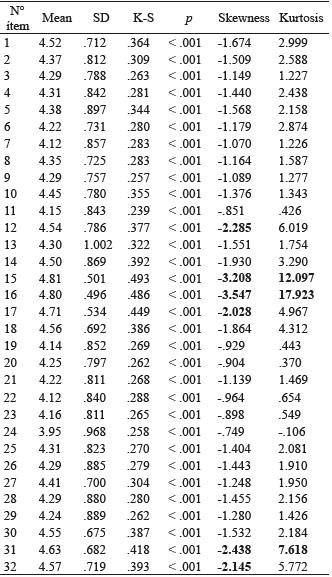
Taking into account that there was no normality in the distribution of the items, it was decided to use the principal components method, which is considered as more appropriate for these cases (Abad et al., 2011). The rotation procedure chosen was the orthogonal varimax in order to coincide with the one used in the original scale (González-Arratia, 2016).
Once the items that did not comply with the normality assumption were eliminated, a first exploratory study was carried out. Before getting the final model, two previous models were evaluated. In the first one, there were five dimensions which explained 61% of the variance (KMO = .91, p <.001, communalities> .50, X2 = 3302.206, gl = 325). In search of the model with better adjustment indicators and taking into account the considerations raised by Méndez and Rondón (2012), it was decided to eliminate items 30, 18, 9 and 23 because they had factor loads less than .50, considered of minimum contribution. In the same way, from the second model, which included five dimensions that explained 63.69% of the variance (KMO = .90, p <.001, communalities> .50, X2 = 2616.996, gl = 231), the items 28 and 5 were eliminated for the reason described above; followed by the items 22 and 19, for not reaching the criterion of a minimum of three elements to constitute a dimension.
Through the depuration of items, a final factorial model with four dimensions that explained 61.18% of the variance was obtained, with a KMO = .90 index and a significant Bartlett sphericity test (X2 = 1879.924, df = 153, p <.001), with communalities higher than .50 for all items. The eigenvalues found ranged from 6.8 to 1. The minor factor load of the items was .50 and the largest was .82.
Since factors one and three showed a high correlation, it was decided to carry out an AFE with the items involved. The results corroborate that these are two differentiated factors (KMO = .908, Bartlett <.001, communalities >.40, eigenvalues: component 1: 4.69, component 2: 1.14, variance explained 58.23%), whose items are distributed in the same way as in the previous analysis.
Table 3 shows that the five items that make up the first component are part of the dimension called internal protective factors of the original scale, which is described as interpersonal skills and conflict resolution skills. It was decided to rename the factor as insight, in order to distinguish it from the third dimension obtained in the present analysis.
Table 3 Factorial structure matrix obtained for the Cuestionario de resiliencia para niños y adolescentes.
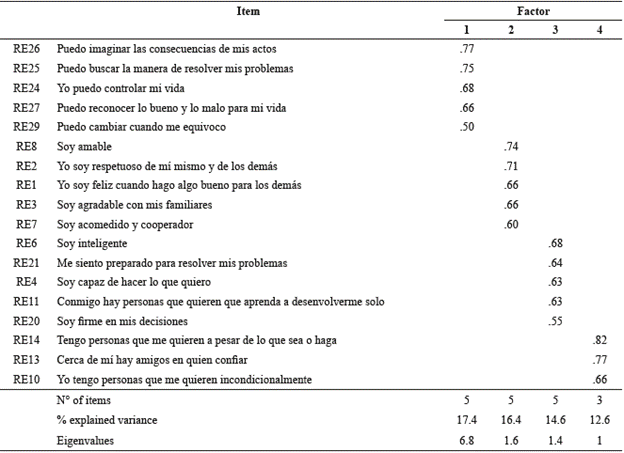
Note. Factors: 1. Insight, 2. Empathy, 3. Problem solving, 4. External protective factors. Source: Author's elaboration.
The five items of the second dimension correspond to the empathy factor of the original scale, with the exception of item 1 (“Yo soy feliz cuando hago algo bueno para los demás") ["I am happy when I do something good for others"] that in the original instrument is part of the external protective factors. In any case, it was decided to keep it in the component due to its factorial load and relevance.
The third dimension comes from both internal and external protective factors. Its five-item factor structure allows it to be organized under the name of problem solving.
The three items that integrate the fourth component belong to the external protective factors dimension of the original questionnaire, which is why its name was preserved.
Confirmatory Factor Analysis
In the random sample for the Confirmatory Factor Analysis (CFA) there were a total of 261 students with 52.9% (138) of women and 47.1% (123) of men. The mean age was 15.02 years (SD = .526), with a minimum of 14 and a maximum of 18.
The final model showed a four-factor configuration composed of 18 valid items. Table 4 shows the absolute fit indices for the models emerged from the exploratory factor analysis, where the final model of 18 items present the best indicators.
Table 4 Comparison of absolute fit goodness indices by model.

Note. a Eliminating items 12, 15, 16, 17, 31 y 32. b Eliminating items 30, 18, 9 y 23. c Eliminating items 28, 5, 22 y 19.
On the other hand, table 5 shows the incremental adjustment indexes as a benchmark, where the final model exhibits the best scores.
Table 5 Comparison of incremental goodness of fit indices by model.

Note. a Eliminating items 12, 15, 16, 17, 31 y 32. b Eliminating items 30, 18, 9 y 23. c Eliminating items 28, 5, 22 y 19.
Figure 1. shows the final structural equation model of the Cuestionario de Resiliencia para niños y adolescentes - Revised.
Reliability analysis by dimension
Table 6 shows the general reliability and subscale indices. The total scale reached an excellent level of reliability, while the dimensions of insight and empathy obtained a good level of reliability. On the other hand, the problem solving and external protective factors dimensions achieved an acceptable level of reliability.
Convergent and divergent validation
Since the sample did not present normality in the distribution, a correlation analysis was carried out using Spearman's rho test, with the purpose of establishing the convergent and divergent validity of the questionnaire.
The convergent validation was carried out by correlating the dimensions of the Cuestionario de Resiliencia para niños y adolescentes - Revised with the Rosenberg Self-Esteem Scale, obtaining significant correlations at the 0.01 level for all dimensions. As can be seen in table 7, moderate correlations were found for Empathy and Problem solving, as well as for the whole scale. On the other hand, Insight showed a low correlation, while the dimension of External protective factors exhibited a very low correlation.
The divergent validation was established based on the correlations between the dimensions of the Cuestionario de Resiliencia para niños y adolescentes - Revised and the CES-D-R. Table 7 shows the results, in which significant correlations can be observed at the 0.01 level, except for Emotional well-being, where only a significant correlation with Problem solving was found at 0.05 level. The Empathy factor and the total resilience were correlated with a moderate level of magnitude, with the exception described above. Likewise, Problem solving presented a moderate correlation with Positive affection, while the rest of the dimensions obtained very low correlations.
Discussion
The aim of this study was to perform an analysis of the psychometric properties of the Cuestionario de resiliencia para niños y adolescentes. The key finding is to offer a modified model with a satisfactory factor structure and an excellent level of reliability.
The original questionnaire is composed of 32 items which through factorial reduction resulted in 18 items with better indicators. In addition, the model consisted of three dimensions: External protective factors, Empathy, and Internal protective factors; the first two factors were preserved, adding two emerging dimensions: Insight and Problem solving. One possible explanation for the emergence of these factors is the complexity of the construct that manifests itself in different skills, an approach similar to that reported in the literature (Luthar, 2015, Rutter, 2012, Walsh, 2004).
The factorial grouping of the obtained dimensions coincides with the original theoretical model taken up by González-Arratia (2016), where the dimension I have (external support) corresponds to External protective factors; the dimension I am (inner strength) would enter into Empathy; while the dimension I can (interpersonal skills and conflict resolution) would correspond to Insight and Problem solving.
In relation to cultural adaptation, it is interesting to note that in the Anglo-Saxon version, the model is composed of three factors: I have, I am and I can (Grotberg, 1995, 2006), which in Spanish have been represented as four due to the dual character of the verb to be, appearing as Yo tengo, Yo soy, Yo estoy, Yo puedo (Melillo & Suarez, 2001). Although four dimensions were found in the present study, they do not correspond to such approach, but rather they adhere more to the original model, where, as previously mentioned, the factor I can integrates the factors of Insight and Problem solving.
Likewise, emerging dimensions are pertinent to the literature, coinciding with the theoretical elaborations on resilience, which consider that insight or introspection implies the ability to interpret situations or people adjusting one's interpersonal behavior, manifesting a knowledge of oneself and the others (Grotberg, 1995, Hurtes & Allen, 2001, Luthar, 2015), whereas the notion of problem solving was already included in the original dimension called Internal protective factors (González-Arratia, 2016) agreeing with what was previously reported (Rutter, 2012).
The analysis of the psychometric properties allowed to support the structure of four differentiated dimensions, showing adequate absolute and incremental fit indices, which support the multidimensional approach of the resilience construct (Hurtes & Allen, 2001; Luthar, 2015; Walsh, 2004).
The analysis of convergent validity empirically corroborates the close relationship between resilience and self-esteem, widely reported in the literature (González-Arratia, Reyes, Valdéz & González, 2011, Luthar, 2015, Rutter, 2012, Walsh, 2004); while divergent validity tests support the evidence of the negative association between resilience and depression (Restrepo-Restrepo, Vinaccia & Quiceno, 2011).
As proposed by Hurtes and Allen (2001), an instrument - in order to be useful - must be simple, easy to administer and interpret, appropriate for the population and relevant for the purposes of the intervention. All of these criteria are met by the Cuestionario de resiliencia para niños y adolescentes - Revised, solving the demands for validation, cultural and contextual adaptation (Luthar & Cushing, 2002, Windle et al., 2011).
There are three main practical implications of the use of the Cuestionario de resiliencia para niños y adolescentes -Revised. First, the possibility of making comparisons between different samples using a reliable instrument. Second, it allows the elaboration of interventions that have empirical support for the operationalization of the dimensions of resilience. Finally, it can be used to evaluate and justify the effectiveness of interventions and programs in the form of workshops designed with the resilience approach from a strength-centered perspective. It is worth mentioning that it is important to enrich the psychometric evaluations with psychological and contextual contributions that allow understanding the complexity of the resilient processes (Belykh, 2018).
In this way, developing interventions aimed at enhancing insight, empathy, external protective factors and problem solving will favor adolescents' ability to cope with the normative and unexpected adversities of life, that is, they will contribute to their resilience.
The main contribution of this article to the literature on resilience, lies in the refinement of the psychometric properties of the Cuestionario de resiliencia para niños y adolescentes, highlighting that it is an instrument that has been developed from the Mexican context. The type of sampling and the age range are recognized as limitations, so it is recommended that studies with randomized samples be carried out in different populations, especially in primary and secondary school children. In the same way, it is suggested to evaluate the stability of the instrument though the test-retest method and to develop longitudinal investigations. Finally, the elaboration of the instrument's assessment scales that allow for its clinical use is still pending.
In conclusion, the Cuestionario de resiliencia para niños y adolescents - Revised has adequate psychometric characteristics, both in its factorial structure and reliability, as well as in convergent and divergent validity, for which it is proposed as a useful instrument for assessing resilience in Mexican adolescents.











 text in
text in 

